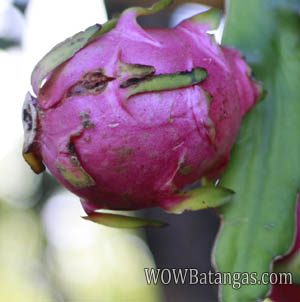
Last year, I remember giving a friend with this seemingly odd fruit they call dragon fruit (pitaya). My friend happened to be a fuschia pink enthusiast and so I didn’t think twice about giving her this pink fruit despite its “scale-y and fire-y” skin. I thought she would surely appreciate anything pink but the moment she opened my present, she raised her eyebrow and wondered about what in the world is this pink fearsome thing. (By the way, I did give it to my friend because we were asked to give “something healthy” for our monitos and monitas.)
Now, I’ve been wondering about this bizarre looking fruit, I haven’t tried it myself though I frequently see this on fruit stalls and malls. It usually catches my attention for it is the only thing pink amid all the luscious green, yellow and all typical fruit colors.
With so many questions in mind, i google about this dragon fruit. My research says that dragon fruit’s scientific name is Hylocereus Undatus. It is a tropical plant that belongs to the Cactaceae family, native to the Americas. This is the most popular cactus because of its edible fruits, which are also called strawberry pear, now sold in most supermarkets throughout the world.
The dragon fruit is said to be nutritious, containing vitamin C, minerals and dietary fiber. It also helps control levels of glucose blood sugar levels in type 2 diabetes (and type 1 diabetes by some reports). This fruit as is likewise a natural source of anti-oxidants which help prevent the dangers of free radicals which can cause cancer and other undesirable health detriments. (source)
By knowing all these, I guess I certainly did the right decision to choose pitaya as my “something healthy” present for my friend.
Meanwhile, I just recently discovered that we already have dragon fruit farms here in Batangas. One of the largest pitaya farms is located at Soro-Soro, Batangas City.
According to a pitaya farmer, Dragon fruit grows in any porous, well-drained soil – one part garden soil, one part river sand, one part coco coir dust, one part rice hull and one part coarse perlite.
We can simply place pitaya plant in full sunlight and provide stakes or poles for the plant to climb on. It is easy to grow pitaya. A plant costs more or less P120 which could bear succulent pitaya fruit in just five months. A promising business right?
Now, what about the taste? Hmm… maybe this is something I would like to experience myself. I guess I better go to a supermarket first and purchase one so I could personally share with you how this dragon fruit tastes like.
[tags]Dragon Fruit, Pitaya, dragon, Soro Soro, Batangas, Batangas City, SM, Robinsons, Malls, Pitay Industry, Dragon fruit business, farms,[/tags]
 WOWBatangas.com Your Source of Great News and Stories from the Province of Batangas, Philippines
WOWBatangas.com Your Source of Great News and Stories from the Province of Batangas, Philippines



